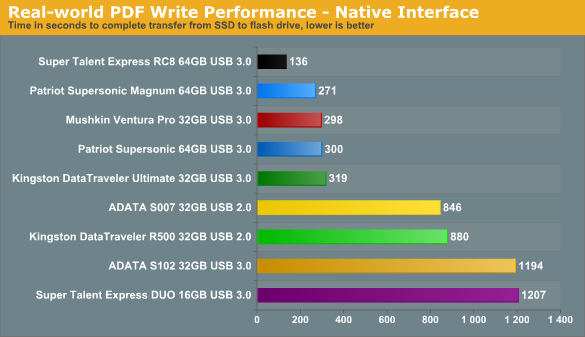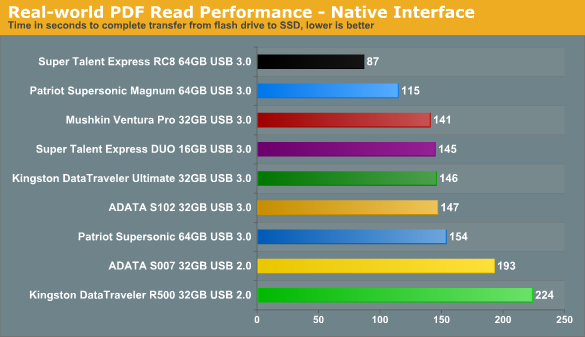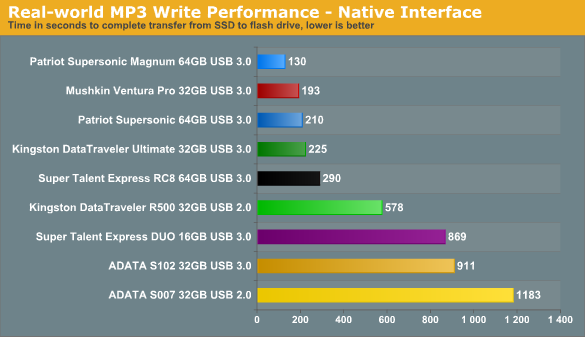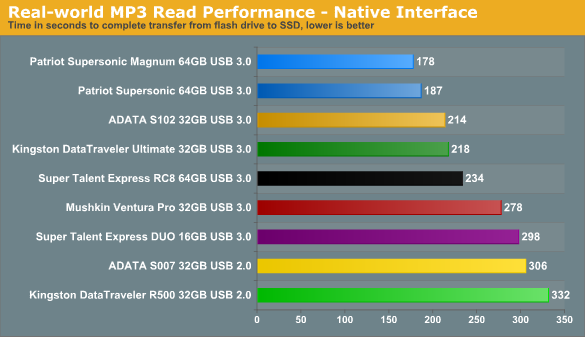USB 3.0 Flash Drive Roundup
by Zach Throckmorton on July 29, 2011 11:15 AM EST- Posted in
- Storage
- Kingston
- USB 3.0
- Patriot
- Gadgets
- ADATA
- Super Talent
- Flash Drive
- Mushkin
Real-world native interface comparisons
As described on the second page of this article, I performed a number of tests that reflect how I use flash drives. I am primarily a research scientist, and I also I love to listen to music and watch movies. Thus, flash drives in my possession are pressed into transporting three file types: small, compressible files like PDFs and office documents, MP3s, and DVD ISOs. If you are a programmer, you might be more interested in seeing how these drives fare with very small files of short pieces of code. If you are an astrophotographer, you might be interested in how flash drives handle RAW files that are hundreds of megabytes in size. As you can imagine, there are literally as many flash drive use patterns as there are folks who use flash drives, and testing them all simply is not feasible. That said, between these real-world timings and the synthetic benchmarks, you can make informed decisions when buying flash drives!

The Super Talent RC8 absolutely screams writing small, compressible files. I contacted both ADATA and Super Talent regarding the poor performance of the S102 and Express DUO, respectively, for this particular test. ADATA acknowledged the garbage collection algorithms of their S102 controller result in noticeable performance degradation during sustained writes of small files. They reported they'll be implementing new controllers in their S102 line of USB 3.0 flash drives.

The Super Talent RC8's lead is diminished but still present. If you frequently move lots of smaller files like PDFs and office documents, the RC8's the drive for you.

Patriot's Supersonic Magnum takes first place in sustained MP3 writes. The issue with the controllers of the ADATA S102 and Super Talent Express DUO continue to retard their sustained write performance of approximately 5MB file size MP3s. Also notice the Kingston R500 handily bests its USB 2.0 competitor from ADATA.

The Supersonic Magnum again produces the fastest MP3 transfer rates. If you're a mobile DJ, that's your drive!

Unsurprisingly, the four drives with the highest 100MB sequential write benchmarks in Iometer perform the best writing a single 4.2GB ISO file.

There's less than a 10% separation between the seven USB 3.0 flash drives for sustained single large file read. This chart vividly illustrates how much faster USB 3.0 can potentially be compared to USB 2.0, with the USB 3.0 drives performing more than 100% faster than their USB 2.0 counterparts. Note that we're nowhere near the theoretical transfer rate of USB 3.0 either, so future drives (and controllers) will likely be even faster.
These charts elucidate how superior Iometer synthetic benchmark performance of USB 3.0 flash drives translate into superior real-world performance. Super Talent's Express RC8 is particularly impressive in its ability to write many small, compressible files like PDFs and office documents. Writing many sub-1MB files is a pointed weakness of all flash drives, so the RC8's controller technology is aimed squarely at a glaring issue. And it hits it dead center!
The controller issue that afflicts the ADATA S102 and Super Talent Express DUO USB 3.0 flash drives during sustained smaller (i.e. <10MB) file sizes is a deal-breaker for me given my usage patterns. However, it's important to note that the performance degradation only occurs when transferring many files (the PDF and MP3 tests here each transfer thousands of files). This performance degradation does not occur when transferring a handful of files. You might or might not run afoul of their Achilles' Heel.
The question remains whether USB 3.0 flash drives outperform USB 2.0 devices when both are utilizing a USB 2.0 interface. Find out on the next page!










42 Comments
View All Comments
BadThad - Monday, August 1, 2011 - link
Good job, nice little test!For my purposes a simple 4 or 8MB USB 2.0 drive is fine. Most of the files I need to move around are small and it's only a couple of seconds for read/write ops. As often as I lose these or they just outright die, I can't see spending more than $10 or so on a flash drive.
7Enigma - Monday, August 1, 2011 - link
I assume you mean GB? :) And I'm with you there. I have an 8GB and only occasionally wish I had a 16 or 32 and most of the time it's because I'm too lazy to remove unneeded data.casteve - Monday, August 1, 2011 - link
Thanks for the review. I use thumb drives for archiving data. Create a ZIP or RAR file and place it into a truecrypt folder. With USB 2.0, it's faster to compress using the internal drive and then transfer onto the external drive's truecrypt folder. With 3.0 thumb drives, maybe the transfer rate is fast enough just compress on the fly. It'd be nice to see this proved out.epobirs - Tuesday, August 2, 2011 - link
I've got a Corsair Flash Voyager 16 GB USB 3.0 unit. They've been down around $20 or less AR recently. It's definitely faster (and about 33% longer physically) than its USB 2.0 equivalent but I wonder it would have fallen in this lineup.I carry a bunch of drives for my job and have been retiring 8 GB and smaller units and replacing them with 16 GB models now that the cost per gigabyte is the same, around $1, in promo specials. The Corsair is enough faster that I'll now buy only USB 3.0 drives as good deals appear, preferably 32 GB models.
I might be satisfied when I have a dozen terabytes in my cargo pants pocket but I won't know until I get there. My definition of a decent software and video library to take with me everywhere keeps growing and the cloud does not strike me as a reliable substitute yet or possibly ever.
jagaimo - Wednesday, August 17, 2011 - link
USB 2.0 has a maximum bandwidth of 480Mbits/s, or 60MBytes/s. On a good number of these benchmarks, even the USB 3.0 parts don't hit that speed.e.g., 100MB Sequential Write Performance - Native Interface. The Adata S102 32GB USB3.0 unit only hits 38MB/s. It's still short of the USB 2.0 speed limit.
I guess my point is this... The 480Mb/s bandwidth of USB 2.0 isn't the limiting factor. It seems like it's something else. Is there a reason why we don't see 60MB/s transfers on the 2.0 devices?
MGSsancho - Tuesday, September 6, 2011 - link
That's 640mbs total in both directions. It is really 320mbs in each direction.http://www.usb.org/developers/docs/ see the specs
jonathan1683 - Saturday, September 17, 2011 - link
I would have liked to see 32 GB ones in the mix, but they might be in another article. I have a 16gb flash voyager and it always takes forever reading it initially. Sometimes a couple minutes just to initiate a directory listing. Does anyone know if this is common or maybe I have a defective unit? I notice I don't have this issue on windows XP it's only on win7.tkafafi - Tuesday, March 20, 2012 - link
I think the writeup did a great job of providing the experimental data. I'm just wondering what is the explanation for the results seen on the mixed usb2/usb3 systesm, as they were surprising for sure.Thanks
j7n - Friday, September 20, 2013 - link
Early USB flash memory wasn't "agonizingly slow" in comparison to floppies and rewritable CDs, especially if you account for the time needed to verify the recording on those discs because they were so unreliable. A USB 1.1 port could practically do around 600-700 kB/s, which is at least fifteen times that of a floppy.hizoka - Thursday, December 26, 2013 - link
Silicon Power USB 3.0 Flash Drive, Read/Write Speed Up to 90/60 Mbps16 GB 10.99 $ FREE Shipping
32 GB 19.99 $ FREE Shipping
64 GB 35.98 $ FREE Shipping
in Amazon
http://goo.gl/a3O6V7